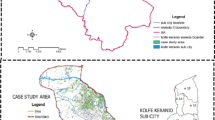Abstract
Herding-based livelihood is a traditional production system in arid and semi-arid areas characterized by a dynamic and flexible self-adapting structure to adjust to unpredictable climate changes and unfavorable natural conditions. In this case, indigenous knowledge and information systems play a pivotal role in linking such structures to changing conditions. Taking such role into account, an attempt was made to investigate the nomadic knowledge of local people residing in summer rangelands of Semirom Township in Isfahan Province, Iran, gained in response to climate change. A cluster sampling procedure was used to extract the case study population from a number of nearly 7700 Qashqai nomads divided into four, Dare shoori, Amale, Shesh blocki, and Farsimdan, clans in which grazing systems were recognized as clusters or sampling units. In-depth group interviewing and exploratory methods were then used to assess the role of nomadic indigenous knowledge and insights into utilization of summer rangelands gained on adaptation to climate change and data collected from interviews were analyzed using content analysis. The results showed that people of Qashqai tribes have a thorough knowledge of climate change and have adopted long-term adaptive solutions such as building cement-block houses and water storage ponds as well as changing the migration routes and locations to cope with the adverse consequences of climate change.






Similar content being viewed by others
References
Barani H (1996) Evaluation and comparison of assessment methods in line with the habitat in some areas clime zone of Tehran. MSC thesis of range management, College of Agriculture and Natural Resources, Tehran University, Karaj, 66
Bouzarjomhari KH, RuknoDin Eftekhari R (2005) Analyzing the role of indigenous knowledge in sustainable rural development. Madras Journal of Human Sciences 9(1):17–45
Calvosa C, Chuluunbaatar D, Fara K (2009) Livestock and climate change. International Fund for Agricultural Development, Rome, Italy pp 20
Chung YS, Yoon MB (2000) Interpretation of recent temperature and precipitation trends observed in Korea. Theor Appl Climatol 67:171–180
Dudgeon RC, Berkes F (2003) Local understandings of the land: traditional ecological knowledge and indigenous knowledge. In: Selin H (eds) Nature across cultures. Science across cultures: the history of non-Western Science, Nature across Culture, vol 4, pp 75–96. https://doi.org/10.1007/978-94-017-0149-5_4
Ehlers E, Schetter C (2001) Pastoral nomadism and environment: Bakhtiari in the Iranian Zagros Mountains. Petermanns Geogr Mitt 145(2):44–55
Emadi M, Amiri Ardakani, M (2011) Indigenous knowledge of livestock. Shi’a Studies program, Department of Extension and operating systems, Tehran, pp 54
FAO (2007) Adaptation to climate change in agriculture, forestry, and fisheries: perspective, framework and priorities. FAO, Rome
Hartman I, Sugulle AJ (2009) The impact of climate change on pastoral societies of Somaliland, Candlelight for Health, Education & Environment, European Union and Heinrich Boll Foundation, pp 62
Herath S, Ratnayake U (2004) Monitoring rainfall trends, to predict adverse impacts-a case study from Sri Lanka 1964-1993. Glob Environ Chang 14:71–79
IPCC (2007) Climate change 2007: synthesis report. In: Pachauri RK, Reisinger A (eds) Contribution of working groups I, II and III to the fourth assessment report of the intergovernmental panel on climate change. IPCC, Geneva, Switzerland, pp 104
Khodagholi M (2008) Zonation of drought. Department of Natural Resources in Isfahan Province, Esfahan, pp 167
Khodagholi M, Esmaeili sharif M, Feyzi MT, Shahmoradi A, Jaberolansar Z (2010) The effect of sowing methods on germination of Astragalus caragana F.et M. species in dry conditions (case study on Zayandehrood station). Watershed Management Research 86:8–14
Lahmer W (2002) Trend and climate change impact analysis on the mesoscale, International conference convened by the European Network of Experimental and Representative Basins (ERB) and UNESCO IHP Northern European Friend Projects. Demanovska dolina, Slovakia
Naeebi H (2009) Content analysis: principles methodology. Ney Publishing, Tehran, pp 262
Papzan A, Afsharzadeh N (2010) Local management mechanisms of Kalhor tribe. Iranian Journal of Range and Desert Research 17(3):476–488
Safinejad J (1996) Tribes of central Iran. Tehran Amir Kabir Publishing Institute, Tehran, pp 736
Tahmasebi A (2012) Pastoralism under pressure: vulnerability of pastoral nomads to multiple socio-political and climate stresses – the Shahsevan of Northwest Iran. PhD thesis 197
Tapper R (1979) Pasture and politics: economics, conflict, and ritual among Shahsevan nomads of northwestern Iran. (Studies in anthropology); Pasture and Politics. London, Academic Press, p 312
Yu PS, Yang TC, Kuo CC (2006) Evaluating long-term trends in annual and seasonal precipitation in Taiwan. Water Resour Manag 20:1007–1023
Acknowledgements
Thanks to Dr. Yusefi for conducting field research and guidance on doing all this better and also thanks to the Isfahan Nomad Affairs office for providing better research conditions.
Author information
Authors and Affiliations
Corresponding author
Rights and permissions
About this article
Cite this article
Saboohi, R., Barani, H., Khodagholi, M. et al. Nomads’ indigenous knowledge and their adaptation to climate changes in Semirom City in Central Iran. Theor Appl Climatol 137, 1377–1384 (2019). https://doi.org/10.1007/s00704-018-2665-4
Received:
Accepted:
Published:
Issue Date:
DOI: https://doi.org/10.1007/s00704-018-2665-4




